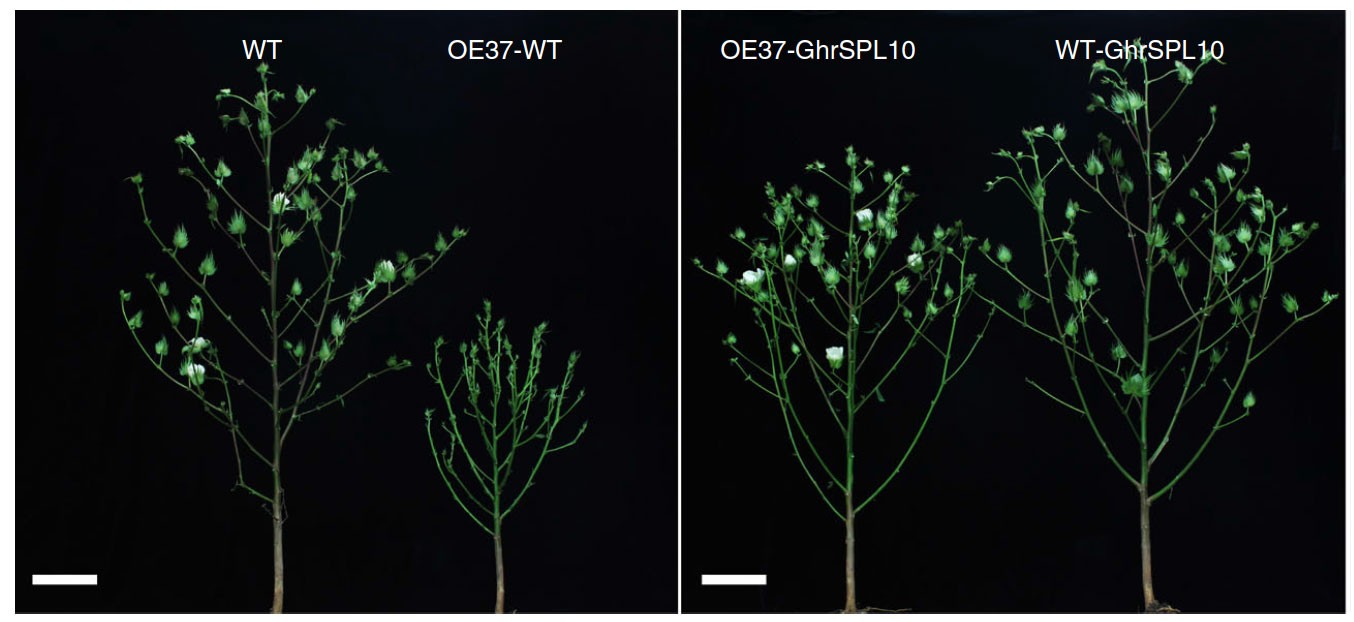博文
Communications Biology:棉花HD-Zip转录因子控制开花时间和植株株型
||
The cotton HD-Zip transcription factor GhHB12 regulates flowering time and plant architecture via the GhmiR157-GhSPL pathway
First author: Xin He; Affiliations: Huazhong Agricultural University (华中农业大学): Wuhan, China
Corresponding author: Longfu Zhu
Domestication converts perennial and photoperiodic ancestral cotton to day-neutral cotton varieties, and the selection of short-season cotton varieties is one of the major objectives of cotton breeding. However, little is known about the mechanism of flowering time in cotton. Here, we report a cotton HD-ZIP I-class transcription factor (GhHB12) specifically expressed in axillary buds (腋芽), which antagonisticlly interacts with GhSPL10/13 to repress the expression of GhFT, GhFUL, and GhSOC1, resulting in bushy architecture and delayed flowering under long-day conditions. We found that GhHB12-mediated ancestral upland cotton phenotypes (bushy architecture and delayed flowering) could be rescued under short-day conditions. We showed that overexpressing of GhrSPL10 partially rescues the bushy architecture and delayed flowering phenotypes, while overexpression of GhmiR157 reinforced these phenotypes in GhHB12-overexpressing plants. This study defines a regulatory module which regulates cotton architecture, phase transition and could be applied in the breeding of early maturing cotton varieties.
驯化将多年生光周期棉花祖先种转变成了日中性棉花品种,短季棉花棉花品种的选育是棉花育种中的主要目的之一。然而,对于控制棉花开花时间的分子机制了解得还很少。本文研究显示棉花HD-ZIP I类转录因子GhHB12特异性在腋芽中表达,与GhSPL10/13拮抗互作以抑制GhFT、GhFUL和GhSOC1的表达,导致长日照条件下密集株型和开花延迟。作者发现GhHB12介导的古老的陆地棉和密集株型和开花延迟表型可以在短日照的条件下被拯救。研究显示在过表达GhHB12的植株中过表达GhrSPL10会部分恢复密集株型和开花延迟表型,而过表达GhmiR157则会加强这些表型。本研究鉴定了调控棉花株型结构、状态转变的调控模块,对于早熟棉花品种的育种具有潜在应用价值。
通讯:朱龙付 (http://cpst.hzau.edu.cn/info/1015/1579.htm)
个人简介:2004年,华中农业大学,博士;2007-2008年,美国德州理工大学,合作研究;2014年,荷兰瓦赫宁根大学,合作研究。
研究方向:棉花与黄萎病菌互作分子机制研究;棉花基础免疫信号网络与调控;棉花早熟多抗分子育种。
doi: https://doi.org/10.1038/s42003-018-0234-0
Journal: Communications Biology
Published date: 13 December, 2018
https://blog.sciencenet.cn/blog-3158122-1151964.html
上一篇:Plant Biotechnol J:DNA甲基化作用于棉花转基因的表达
下一篇:New Phytologist:丛枝菌根分泌CLE多肽利于与植物的共生
全部作者的其他最新博文
- • Plant Physiology:CsMADS3促进柑果中的叶绿素降解和类胡萝卜素合成(华中农业大学)
- • Molecular Plant:LBD11-ROS反馈调节作用于拟南芥的维管形成层增殖和次生生长(浦项科技大学)
- • Science Advances:根结线虫通过调控植物的CLE3-CLV1模块,促进侵染进程(日本熊本大学)
- • Nature Communications:油菜素内酯参与植物营养生长期转变的分子机制解析(浙江农林大学)
- • Current Biology:光合作用产生的蔗糖驱动侧根“生物钟”(德国弗莱堡大学)
- • PNAS:花同源异型基因在叶中被抑制、花中被激活的分子机制(南卡罗来纳大学)

